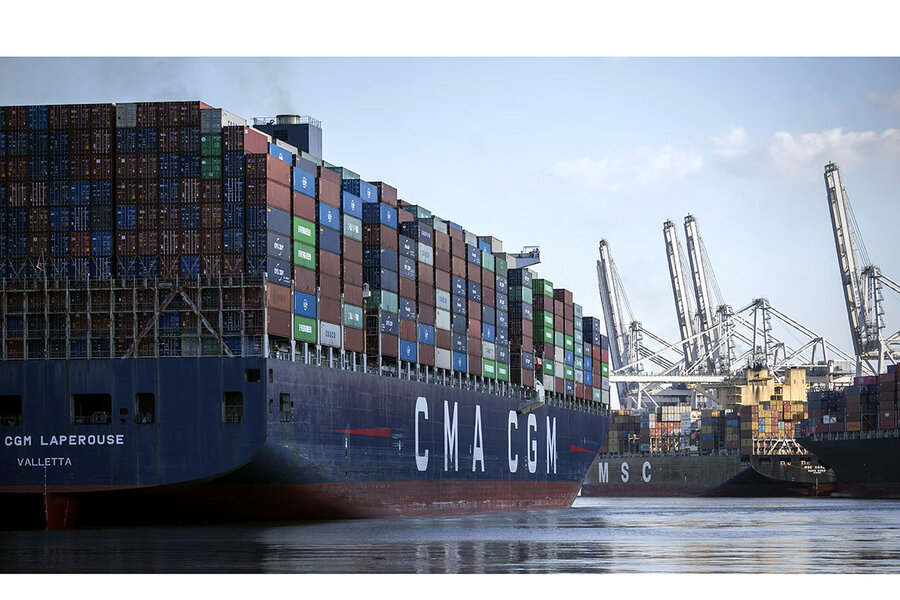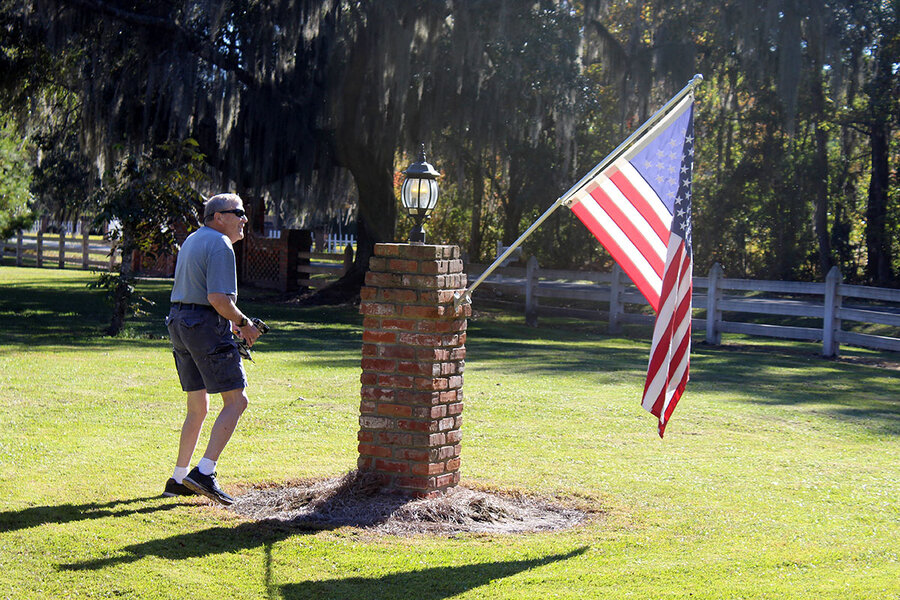Can the US still build – and think – big? The Lowcountry may hold clues.
Loading...
| Garden City, Ga.; and Hardeeville, S.C.
Fifteen years ago, South Carolina state Sen. Tom Davis had an epiphany. He realized that a massive pile of river dredge in a crook of the Savannah River could become a cornerstone of the state’s economy. A $5 billion project called the Jasper Ocean Terminal was born.
And then it stalled, mired in bureaucracy and regional competition. Now, with kinks in the supply chain that have shipping containers stacked like Legos at U.S. ports, the Jasper Ocean Terminal may move forward – if neighbors Georgia and South Carolina can cooperate.
Why We Wrote This
For the past 50 years, America has seen a continuous decline in infrastructure spending, or planning for the future. Will Joe Biden’s signature bill encourage regions to work together to get some long-stalled projects off the nation’s drawing boards?
On Monday, President Joe Biden signed a $1.2 trillion infrastructure bill designed to unlock supply chain capacity and bring jobs to places like Jasper County, one of South Carolina’s poorest.
It is a promise of short- and long-term investments, experts say, hewn in steel and welding rods, bulldozers, and routers.
But Mr. Biden’s ambitious outlook also tugs at deeper American questions, including the country’s capacity to think, dream, and do big. It won’t be easy in today’s toxic political climate.
Whether federal dollars can help break planning logjams, infrastructure experts say, will be a longer-term test for a new direction for American priorities.
“‘Why do we need infrastructure?’ is a fundamental question we should be asking,” says Manish Shirgaokar at the University of Colorado Denver.
Given the towers of shipping containers stacked like giant Lego blocks at the Port of Savannah’s Garden City Terminal, President Joe Biden’s signature on a historic infrastructure spending bill Monday comes just in time for Christmas.
The port has nearly run out of room, meaning that more than two dozen ships are at times anchored offshore. It’s a snapshot of a pandemic economy: Supply chains are crimped, prices are up, and containers sit, jimmied by five-story forklifts into every available cranny.
President Biden’s signature opens a funding stream to let the Georgia Port Authority secure five “pop-up container yards” to alleviate the crush. That means that the flow of goods could be improved by the time the holiday caroling starts.
Why We Wrote This
For the past 50 years, America has seen a continuous decline in infrastructure spending, or planning for the future. Will Joe Biden’s signature bill encourage regions to work together to get some long-stalled projects off the nation’s drawing boards?
To be sure Mr. Biden, his approval rating struggling, is thinking bigger than presents under the tree. The president a few weeks ago said that the new $1.2 trillion spending package would be “unlike anything we have seen or done since we built the interstate highway system and the space race decades ago.”
It is a promise of short- and long-term investments, experts say, hewn in steel and welding rods, bulldozers, and routers.
But Mr. Biden’s ambitious outlook also tugs at deeper American questions, including the country’s capacity to think, dream, and do big. It won’t be easy in today’s toxic political climate.
Just down the river from Garden City, in South Carolina’s Jasper County, plans for a long-delayed 1,500-acre port terminal may hang in the balance.
Whether federal dollars can help break logjams, infrastructure experts say, will be a longer-term test for what is decidedly a new direction for American priorities – not just higher wages and more jobs, but more equitable economic benefits along lines of class, race, and gender.
The bill shows “the value in political actors working together for the benefit of the region, because it makes a lot less difference to individuals whether it happens on one side of a state border or not, as long as there’s a benefit that comes to my side,” says Joseph Schofer, a civil engineering professor emeritus at Northwestern University in Evanston, Illinois.
The White House has said a combination of spending and tax credits would result in 20,000 miles of rebuilt roads, fixes to the country’s 10 most economically important bridges and up to 10,000 smaller ones, the removal of lead pipes from municipal water systems, and myriad other plans aimed at creating millions of jobs. Those jobs, Democrats say, should ease opportunity gaps for marginalized Americans and bolster the country’s economic strength heading into the future.
Can $1 trillion make up for 50 years of decline?
But despite the measure’s trillion-dollar price tag, some infrastructure experts balk at calling it transformative.
That’s because U.S. infrastructure spending – uniquely among large developed nations – began a “monotonic decline” 50 years ago, according to a September paper by Yale University economist Ray Fair. A return to the mean spending up to that point would require about $2.4 trillion in new spending. (The U.S. Treasury is set to spend $550 billion in new dollars. The rest of the infrastructure funds comes from redirecting unused pandemic money and already planned spending.)
The findings “suggest that the United States became less ... concerned with future generations, beginning around 1970,” writes Professor Fair. “The question [of why the U.S. curtailed spending for its future] is probably too big, but the fact is fascinating.”
Perhaps some clues can be gleaned from the polarized politics of the moment – and whether a shift toward a more common national purpose rooted in economic and social fairness is really afoot.
The process of lawmakers bringing federal dollars back to their home states has been a bipartisan tradition in the U.S. And while GOP representatives have gotten death threats for voting in favor of bridges, roads, and jobs, the infrastructure bill passed with support from both parties.
“This bill was crafted in the Senate, 19 Republicans voted for it, I was one of them, I think it was good for the country, and I’m glad it passed,” Senate Minority Leader Mitch McConnell told WHAS radio in Louisville, Kentucky.
Republican Sen. Lindsey Graham of South Carolina also voted for the bill. On the other side of the Savannah River, GOP Rep. Buddy Carter, who represents coastal Georgia, voted no, but last week applauded its provisions for the Port of Savannah.
Plans for Jasper County
Long one of the nation’s poorest states, solidly red South Carolina has seen annual median wages grow by more than $10,000 since 2014, outpacing most other states. It has successfully wooed marquee companies like BMW, Volvo, and Boeing. To be sure, climate and geography play a role. Also key has been a solid technical college system, says Joseph Von Nessen, an economist at the University of South Carolina in Columbia. But the willingness to say yes to federal infrastructure dollars is part of a broader focus on advanced manufacturing.
In and around Jasper County, suburban developments are rising out of the bottomlands. Yankees and Midwesterners are coming in droves to live and work among the live oaks.
Hardeeville, South Carolina, has long been a struggling timber town. Today, in the middle of rumbling lumber tucks and thrumming freight trains, there is a brand-new sports complex that hosts some of the most competitive U-16 girls travel teams in the country. With them come parents and families and their dining and shopping purchases.
Those glimmers of opportunity underscore support for more federal infrastructure dollars.
“Now is a time to focus on ways to enhance infrastructure to be able to capture that demand,” says Dr. Von Nessen. “There are a lot of aligned incentives.”
Unlike President Barack Obama’s infrastructure package, designed to alleviate economic pain from the Great Recession, Mr. Biden’s bill won’t solely focus on so-called shovel-ready projects. Over eight years, it will release some $42 billion toward ports and airports in a bid toward building for the future.
Fifteen years ago, state Sen. Tom Davis, who represents the Lowcountry town of Beaufort, South Carolina, had an epiphany. He realized that a massive pile of river dredge in a crook of the Savannah River could become a cornerstone of the state’s economy. A $5 billion project called the Jasper Ocean Terminal was born.
But early enthusiasm for the project ran headlong into plans for growth at the Port of Charleston, two hours to the north. Longtime rivals Georgia and South Carolina couldn’t meet in the middle. Where would the money come from? Who would get the revenues? Lawsuits came and went.
Consequently, the plan got stuck in marsh mud. In January, after years of lawsuits, the South Carolina Port Authority washed its hands of the Jasper terminal. Now it is up to the Georgia Port Authority whether it wants to partner with Jasper County.
Whether the potential for new funding will reawaken negotiations has become a sudden and serious issue, with huge implications for the Lowcountry’s future.
“They could have built this thing 15 years ago. But you’re dealing with money, you’re dealing with thoughts, you’re dealing with competition,” says John Kemp, a Republican county council member in Jasper County.
At the same time, he says, “this is where you say the iron is hot, because everybody is thinking about new ports and new infrastructure. There’s a lot of pressure to bring us into the 21st century. Everybody looks to the port. At least up to this point, everybody wants to win and nobody wants to compromise. But that’s what government does: compromise.”
Rich Rodman, who retired to a corner of rural Jasper County a few years ago, thinks about infrastructure almost every day.
There’s the road to his house that took 10 years for the county to pave. There are the clogged drain pipes that cause the neighborhood behind his house to flood with just about every big storm.
“It’s like they don’t care about the people,” he says. He’s all for spending money on a new port and roads to get to it.
While Beaufort booms just to the north, and Savannah, Georgia, bustles just to the south, Mr. Rodman says it feels “like here in Jasper County we’re stuck between a rock and a hard place.”
An incentive to move faster
Even when big projects are greenlighted, arduous permitting processes gum up the works. The result is that the U.S., a country that once had dreams that seemed to have no bounds – think the 1969 moonshot – got bogged down in committee.
“Projects that require collaboration end up with people sitting at a long table and pushing responsibility for hard stuff across to the guys on the other side,” says Professor Schofer at Northwestern. “What may make this different – I hope will make it different – is now there’s a big pot of money sitting on that table. That sort of ... reduces the scale of that critical obstacle.”
It also means, he says, that “everybody in this game right now has a motivation to move quickly.”
On paper, infrastructure improvements are simply a way to streamline utilities and make it more efficient to move goods and services from factories and farms to consumers, whether in Dubuque or Dubai.
But social justice upheaval, stubborn opportunity gaps, and growing awareness of how big infrastructure movements like urban renewal have in fact marginalized some Americans may change the equation, says Manish Shirgaokar, a planning professor at the University of Colorado Denver.
“‘Why do we need infrastructure?’ is a fundamental question we should be asking,” says Mr. Shirgaokar.
“We finally have money to build this out, but where is really the demand? What’s the nature of the demand? [It lets us] ... think really about, how do we connect people to opportunity? The lesson from the past is that we have to have humility.”










